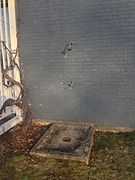Gropius House
|
Gropius House | |
|
| |
|
Gropius House, front view | |
 | |
| Location | 68 Baker Bridge Road, Lincoln, Massachusetts |
|---|---|
| Coordinates | 42°25′37″N 71°19′37″W / 42.42694°N 71.32694°WCoordinates: 42°25′37″N 71°19′37″W / 42.42694°N 71.32694°W |
| Area | 5.51 acres (22,300 m2)[1] |
| Part of | Woods End Road Historic District (#88000956) |
| NRHP Reference # | 00000709 |
| Significant dates | |
| Added to NRHP | May 16, 2000[2] |
| Designated NHL | May 16, 2000[3] |
| Designated CP | July 8, 1988 |
The Gropius House was the family residence of noted architect Walter Gropius at 68 Baker Bridge Road, Lincoln, Massachusetts. It is now a historic house museum, owned by Historic New England, and is open to the public.[4] It was designated a National Historic Landmark in 2000 for its association with Gropius, an influential teacher and leader of Modernist philosophy of architecture.[1][3] The house includes a collection of Bauhaus-related materials that is unparalleled outside Germany.
History
As the first director of the Bauhaus, Gropius was concerned with combining useful modern technologies with consumer need, while placing equal emphasis on architectural integrity and decorative arts.[5]
Gropius and his family came to the United States after a three-year stay in London, which they had moved to avoid the Nazi regime. Gropius went Massachusetts to accept a teaching position at Harvard University's Graduate School of Design. Fellow architect and prominent Boston figure convinced philanthropist Helen Storrow to provide the land and fund both the designing and building process of a home.[6] He designed the home in 1937 and it was built in 1938. Gropius used his new home as a showcase for his Harvard students as well as an example of modernist landscape architecture in America.[7] He chose the area because of its proximity to Concord Academy which his daughter, Ati, was going to attend. It remained Gropius's home from 1938 until his death in 1969.
Marcel Breuer, a fellow architect and friend of the Gropius family, came to the U.S. shortly after the Gropius family, also to become part of the Harvard design faculty. Mrs. Helen Storrow provided a neighboring plot of land to Breuer, where he could showcase his own design philosophies. Gropius and Breuer assisted one another in the construction of their homes, completing their dwellings in 1938 and 1939, respectively.[6] The Gropius House continues to have many pieces of Breuer furniture on display. The house also contains works by Eero Saarinen, Joan Miró, and Herbert Bayer that were given as gifts to Walter Gropius.[4]
At the time of the building of the Gropius House, Walter and Ise's adopted daughter Ati was 12 years old. Gropius took much care in making sure Ati was happy and comfortable, while also allowing her a great deal of input into the design of her own space. Ati chose her warm-toned color palette and much of her furniture, which included a desk Gropius had designed as part of the Bauhaus in 1922. Ati's room was the largest of the three bedrooms, with her own private entrance that included a spiral wrought-iron staircase. Though Gropius could not give her the sand floor and glass ceiling she requested, he did give her a private roof deck so that she could sleep under the stars.[4]
Description
In keeping with Bauhaus philosophy, every aspect of the house and its surrounding landscape was planned for maximum efficiency and simplicity. Gropius carefully sited the house to complement its New England habitat on a grassy rise surrounded by stone retaining walls, amidst wetlands and an orchard of 90 apple trees which the Gropiuses allowed to grow naturally other than a few rounds of mowing during the growing season. Gropius wanted the outdoor space around the home to be an equally "civilized area" and created a lawn that extended twenty feet around the entire house, with a perennial garden expanding in the south by the porch. Although the house sits on a rather flat plot of land, by keeping the woodlands well maintained, the Gropius's were able to retain a broad view of the south, east, and west. His screened porch was placed in such a way that it helps to divide the land around the house into multiple zones, comparable to rooms inside a house. The house was conceived as part of an organic landscape, where Gropius utilized indoor/outdoor spaces to accentuate a relationship between the structure and the site.[7] Before the home's design was even complete, Walter Gropius was hard at work creating the ideal landscape. He selected mature trees from the neighboring forest and helped to transplant them in what would later become his yard. Ise was the predominate landscaper in the family, and she and Walter selected Scotch pine, white pine, elm, oak, and American Beech trees to compliment their surroundings. The Gropiuses also added "rescued" boulders and wooden trellises adorned with pink climbing roses and Concord grapevines to flatter the New England landscape. Bittersweet vines and trumpet vines also connected the home to nature. Ise spent many hours each week planting, weeding, and trimming. She also filled and maintained more than a dozen bird feeders and bird houses on the property and claimed to have known more than ninety birds personally. After a trip to Japan in the 1950s, Mrs. Gropius removed the perennials and covered the ground in a layer of gray gravel, where she then planted azaleas, candytuft, cotoneaster, and one large red-leafed Japanese Maple.
As to my practice, when I built my first house in the U.S.A.—which was my own—I made it a point to absorb into my own conception those features of the New England architectural tradition that I found still alive and adequate. This fusion of the regional spirit with a contemporary approach to design produced a house that I would never have built in Europe with its entirely different climatic, technical and psychological background.
Set amid fields, forests, and farmhouses, the Gropius House mixes up the traditional materials of New England architecture (wood, brick, and fieldstone) with industrial materials such as glass block, acoustic plaster, welded steel, and chrome banisters. The house structure consists of a traditional New England post and beam wooden frame, sheathed with white painted tongue and grove vertical siding. Traditional clapboards are used in the interior foyer, but are applied vertically, to create the illusion of height. The clapboards also performed a practical function as a gallery. Because the works displayed in the Gropius House was almost ever-changing, the wood served as an easy surface to nail into, patch, repaint, and start over again. The home contains a living room that shares an open floor plan with a dining room, kitchen, an office, a sewing room, three bedrooms, and four bathrooms. All bathrooms were positioned in the less-prominent northwest corner of the house, and all used the same plumbing stack for maximum efficiency.[4] One of the most notable differences between the Gropius House and its adjacent homes was the flat roof. While in much of Europe and even in certain parts of the United States flat roofs were becoming quite common, in Lincoln and surrounding areas high pointed roofs with gables were the norm. Gropius fashioned his flat roof with a slight tilt to the center where water could drain off to a dry well on the property.
In 1931, Walter Gropius was asked to write an article describing the ideal livable small home for Architectural Forum. Gropius outlined the most important aspects of the home's design, sounding like a true description of the Lincoln dwelling: "The swelling house should no longer resemble something like a fortress, like a monument of walls with medieval thickness and an expensive front intended for showy representation. Instead it is to be of light construction, full of bright daylight and sunshine, alterable, time-saving, economical and useful in the last degree to its occupants whose life functions it is intended to serve."
Gropius went on to describe an ideal layout of such a house, almost literally outlining the Gropius House composition: "The ground plan... is a geometrical projection of its spacial idea – the organizing plan for moving within a house. The elevation, facade, is the result of that plan and not the starting point... Hence, no artificial symmetry, but a free functional arrangement of the succession of rooms, short, time-saving passages of communication, moving space for children, clear separation between the living, the sleeping, and the housekeeping parts of the house, and finally, proper utilization of the ground and especially the sunny aspect. The bedrooms need morning sun (facing east) the living rooms should have southern to western light, and the northside is left to storerooms, kitchens, staircases and bathrooms."
Gallery
|
Criticism
Not everyone was a fan of the Gropius house, especially conservative neighbors. One particular neighbor, James Loud, felt that the Gropius House clashed with the Colonial Revival style homes of the surrounding neighborhood. According to Loud, both the Gropius House and the home designed by Marcel Breuer looked like "chicken coops."[6]
Preservation
Five years after Walter's death, Ise donated the property to the Society for the Preservation of New England Antiquities (SPNEA) in 1974, though she remained in tenancy for the rest of her life. In 1984, a year after Ise's death, the home became a museum.[6]
See also
- List of National Historic Landmarks in Massachusetts
- National Register of Historic Places listings in Middlesex County, Massachusetts
References
- ↑ 1.0 1.1 Ann Grady and Carolyn Pitts (January 13, 2000) National Historic Landmark Nomination: Gropius House, National Park Service and Accompanying nine photos, exterior and interior, from 1988 and 1997
- ↑ "National Register Information System". National Register of Historic Places. National Park Service. 2007-01-23.
- ↑ 3.0 3.1 "Gropius House". National Historic Landmark summary listing. National Park Service. Retrieved 2008-08-30.
- ↑ 4.0 4.1 4.2 4.3 Historic New England: Gropius House
- ↑ Wasserman, Burton (December 1969). Art Education 22 (9): 17–21. Missing or empty
|title=(help) - ↑ 6.0 6.1 6.2 6.3 Buck, Susan L. (1997). "A Material Evaluation of the Gropius House: Planning to Preserve a Modern Masterpiece". APT Bulletin. Retrieved 3 April 2014.
- ↑ 7.0 7.1 Kramer, Eric F. (Feb 2004). "The Walter Gropius House Landscape: A Collaboration of Modernism and the Vernacular". Journal of Architectural Education 57 (3): 39–47. doi:10.1162/104648804772745247. Retrieved 9 March 2014.
- ↑ Gropius House by Walter Gropius
External links
| Wikimedia Commons has media related to Gropius House. |
| |||||||||||||||||||||||||||||||||||||||||||||||||||||||





